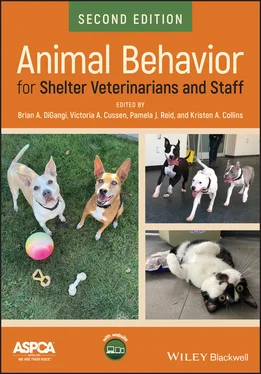Animal Behavior for Shelter Veterinarians and Staff
Здесь есть возможность читать онлайн «Animal Behavior for Shelter Veterinarians and Staff» — ознакомительный отрывок электронной книги совершенно бесплатно, а после прочтения отрывка купить полную версию. В некоторых случаях можно слушать аудио, скачать через торрент в формате fb2 и присутствует краткое содержание. Жанр: unrecognised, на английском языке. Описание произведения, (предисловие) а так же отзывы посетителей доступны на портале библиотеки ЛибКат.
- Название:Animal Behavior for Shelter Veterinarians and Staff
- Автор:
- Жанр:
- Год:неизвестен
- ISBN:нет данных
- Рейтинг книги:5 / 5. Голосов: 1
-
Избранное:Добавить в избранное
- Отзывы:
-
Ваша оценка:
- 100
- 1
- 2
- 3
- 4
- 5
Animal Behavior for Shelter Veterinarians and Staff: краткое содержание, описание и аннотация
Предлагаем к чтению аннотацию, описание, краткое содержание или предисловие (зависит от того, что написал сам автор книги «Animal Behavior for Shelter Veterinarians and Staff»). Если вы не нашли необходимую информацию о книге — напишите в комментариях, мы постараемся отыскать её.
A comprehensive resource to understand the behavioral considerations for intake, management, and rehoming of dogs and cats Animal Behavior for Shelter Veterinarians and Staff
Animal Behavior for Shelter Veterinarians and Staff — читать онлайн ознакомительный отрывок
Ниже представлен текст книги, разбитый по страницам. Система сохранения места последней прочитанной страницы, позволяет с удобством читать онлайн бесплатно книгу «Animal Behavior for Shelter Veterinarians and Staff», без необходимости каждый раз заново искать на чём Вы остановились. Поставьте закладку, и сможете в любой момент перейти на страницу, на которой закончили чтение.
Интервал:
Закладка:
The editors in this edition bring incredible depth and expertise to this book. All four editors have decades of experience working in animal welfare. Dr. Brian DiGangi is the Senior Director of Shelter Medicine at the ASPCA. Being dual board certified in Canine and Feline Practice and Shelter Medicine Practice allows him to bring a unique perspective and deep expertise to this body of work. Dr. Victoria Cussen is a Certified Applied Animal Behaviorist and Senior Director of Applied Behavior Research for the ASPCA’s Behavioral Sciences Team. With expertise in comparative cognition and canine behavior, she has a deep understanding of the scientific literature on animal behavior topics. Dr. Pam Reid serves as Vice President of the ASPCA’s Behavioral Sciences Team. She provides specialized behavioral services, expertise in humane animal handling, behavioral evaluations, placement, and euthanasia recommendations for cruelty cases. Kristen Collins is an Associate Certified Applied Animal Behaviorist, and as Vice President of the ASPCA Behavioral Rehabilitation Center, she oversees all programs and operations with drive and compassion. Together, this revision will be an exemplary contribution to the field of shelter medicine and animal behavior.
This textbook will be a key resource for shelter professionals. Like the first edition, this content was written and edited by top leaders in the field. There are several new topics tackled in this text that will have a positive impact on thousands of sheltering professionals, from science‐driven guidance when making decisions regarding behavioral well‐being, to best practices during transportation of animals, to a focus on behavioral health for dogs and cats that are victims of cruelty or disaster, and much more. We look forward to seeing this edition published and used.
Heather Mohan‐Gibbons, RVT, MS, ACAAB Emily Weiss, PhD
Acknowledgments
First, we would like to thank the authors and editors of the first edition of Animal Behavior for Shelter Veterinarians and Staff . Dr. Emily Weiss, Ms. Heather Mohan‐Gibbons, and Dr. Stephen Zawistowski astutely recognized the need for and importance of a book like this to further the progression of animal sheltering, and their work has laid a solid foundation on which we were able to capitalize. Their enthusiasm and advice as they handed over the reins for the second edition were much appreciated.
We would also like to acknowledge the support and encouragement of our colleagues. Drs. Lila Miller, Stephanie Janeczko, Chumkee Aziz, Erin Doyle, and Elise Gingrich provided thoughtful input on content, played roles as guest editors, and, perhaps most invaluable, served as sounding boards throughout the process. Ms. Rachel Maso assisted in managing this project and enthusiastically took on the unenviable tasks of handling contracts and accounting. Ms. Laura Nelson assisted with preparation of figures, and Carey Parrack provided administrative support, allowing us to focus on content and manuscript preparation.
Finally, we would like to acknowledge the ASPCA’s Executive Leadership Team, particularly Ms. Bert Troughton, Ms. Stacy Wolf, and our CEO, Mr. Matt Bershadker, for recognizing the value a project like this brings to the field of animal welfare at‐large and allowing us to devote time to the effort.
Brian A. DiGangi Victoria A. Cussen Pamela J. Reid Kristen A. Collins
About the Companion Website
This book is accompanied by a companion website:
www.wiley.com/go/digangi/animal 
The website includes:
Appendices – downloadable PDFs from the book
Videos – demonstrations of concepts and techniques presented by the authors
Introduction
“Everyone is on the behavior team.” That is the philosophy of the ASPCA’s Behavioral Rehabilitation Center, a purpose‐built facility designed to house, care for, and treat dogs with extreme fear. However, this philosophy is also applicable outside a specialized rehabilitation facility, even when staffing structure, roles, and responsibilities vary. This approach recognizes that all shelter personnel have important insights and impacts on the behavior and welfare of animals. A collaborative approach to sheltering—from intake to outcome and everything in between—representing the perspectives of medical, behavior, and operations team members, can result in enhanced delivery of care and ultimately improve the entirety of the sheltering experience for the animals and humans involved.
The topics, contributors, and scope of content throughout this book have been chosen and designed to highlight the interplay of all animal care team members toward a shared goal of happy, healthy pets enriching the lives of their humans. The reader will find authors with expertise in animal training, applied behavior, operations and programs, veterinary behavior, shelter medicine, and research—and in many cases authors have been intentionally paired to present as broad a perspective as possible on each topic.
Building upon the foundations laid in the first edition, this volume has been divided into five sections intended to present an evidence‐based approach to the current knowledge of animal behavior in animal shelters. Section 1: Foundations in Behavioral Healthaddresses fundamental concepts important for the application of the principles explored in the subsequent sections and features a new chapter to introduce the reader to learning theory ( Chapter 3). Section 2: Pets in the Communitydescribes the implications of community‐wide programs on the behavioral health of shelter animals and features a timely new chapter on safety net programs to prevent pet relinquishment ( Chapter 5). Section 3: Dogs in the Shelterand Section 4: Cats in the Shelterhave each been expanded to accommodate the ever‐growing knowledge base in topics that were presented together in the first edition. Chapters dedicated solely to advances in animal handling ( Chapters 8and 14), behavior assessment ( Chapters 9and 15), and housing ( Chapter 10and 16) for dogs and cats will focus on practical applications of both old and new concepts. In addition, Section 3 also features an entire chapter on the science and impact of play in dogs along with guidance for the successful, humane operation of playgroups ( Chapter 13). Section 5: Special Topicsencompasses a variety of timely and important topics with direct implications on animal health and welfare. New chapters feature frameworks for welfare assessment and ethical decision‐making ( Chapter 19) and consider programming with particular impact on behavioral health such as animal relocation ( Chapter 20) and the behavioral care of animals during disasters, cruelty cases, and long‐term holds ( Chapter 21). This section also includes an expanded discussion of behavioral pharmacology in animal shelters ( Chapter 22) and introduces concepts in the care of small mammals ( Chapter 23) and horses ( Chapter 24).
The reader is encouraged to use all of the resources compiled to supplement the material in the text. Chapter appendices offer sample protocols and checklists that will help put new knowledge into practice. An online video library is available to demonstrate many of the conditions, concepts, and techniques presented by the authors. General appendices provide ethograms of common canine and feline behaviors as well as a summary of behavior professional credentialing requirements.
Читать дальшеИнтервал:
Закладка:
Похожие книги на «Animal Behavior for Shelter Veterinarians and Staff»
Представляем Вашему вниманию похожие книги на «Animal Behavior for Shelter Veterinarians and Staff» списком для выбора. Мы отобрали схожую по названию и смыслу литературу в надежде предоставить читателям больше вариантов отыскать новые, интересные, ещё непрочитанные произведения.
Обсуждение, отзывы о книге «Animal Behavior for Shelter Veterinarians and Staff» и просто собственные мнения читателей. Оставьте ваши комментарии, напишите, что Вы думаете о произведении, его смысле или главных героях. Укажите что конкретно понравилось, а что нет, и почему Вы так считаете.












